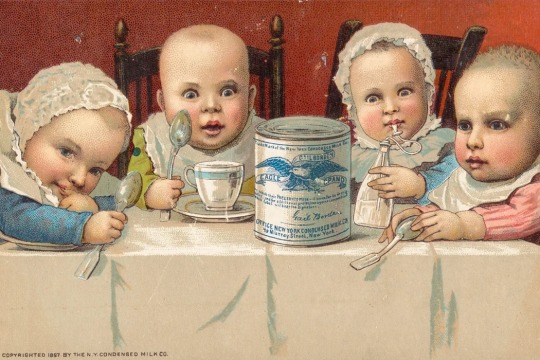#Nestlé | Globalized 🌎 | Dairy Products
Explore tagged Tumblr posts
Text
The Sweet Story of Condensed Milk
This Nineteenth-Century Industrial Product Became a Military Staple and a Critical Part of Local Food Culture Around the World.
— Daily.JStor.Org | By Katrina Gulliver | February 20, 2024

An advertisement for Gale Borden Eagle brand condensed milk, 1887 via Wikimedia Commons
Condensed Milk is a kitchen standard for many of us. There’s a chance you have a small Nestlé tin in the back of your pantry. It’s also a product of a mechanized food culture, representing agricultural progress, a need to address food supply in remote areas, and a triumph of marketing a Western dietary staple (Cow’s Milk), to the rest of the world.
Condensed Milk is milk which has had around 60 percent of its water content removed and sugar added (Evaporated Milk, with which it is sometimes confused, is also milk with water removed, but without the additional sugar). As a technique for preserving milk, it was useful for an industrializing world involving more long-distance travel. Anyone without access to a cow (or refrigeration) could have milk products to use.
Gail Borden was among the first to produce it commercially in the US in the 1850s. Borden himself was a serial entrepreneur, with as many misses as hits, but the timing for the milk was right. As Joe B. Frantz describes it in his essay on Borden’s business career, “When in 1858 Frank Leslie exposed the ‘fresh’ milk producers in New York for selling swill, Borden, scenting opportunity, ran the first newspaper advertisement stating that his milk was not only pure but would keep indefinitely.”
The business wasn’t an immediate success, notes Frantz. As a new enterprise, it “suffered the pangs of slow growth until 1861, when during one noon hour a customer walked in and after asking a few questions, announced that he wanted 500 pounds of condensed milk for the United States Army.” Soldiers fighting in the Southern theaters of the American Civil War were soon being nourished with canned, condensed milk.
“In the Days Where Milk Safety was a Real Public Health Issue (and Children Died From Tainted Fresh Milk), the Option of Mixing up Canned Milk May have Seemed a Safer Choice.”
Borden Became a Military Supplier, and Condensed Milk became known to thousands of soldiers. With its high sugar content, it packed a real caloric wallop in a small can. (It would be in servicemen’s ration packs again in the First World war). Condensed Milk (usually prefaced with the word “Sweetened”) soon became a standard product on grocery shelves in the United States. In Europe, its production was associated with the Anglo-Swiss Milk Company, a forerunner of Nestlé, which led to it being referred to as “Swiss Milk” in English.
In the early part of the twentieth century, condensed (and evaporated) milk were common in recipes for home-made baby formula. In the days where milk safety was a real public health issue (and children died from tainted fresh milk), the option of mixing up canned milk may have seemed a safer choice, even as some Doctors Pointed Out That— Despite Its Boosters’ Claims—It Was Still Often Bacteria-Laden.
(These old recipes were also not nutritionally ideal for infants. During shortages of commercial baby formula powder in recent years, they started circulating online as alternatives, leading doctors to issue warnings against feeding babies Condensed Milk.)
But its civilian usefulness came with bringing milk to hot climates. Condensed Milk soon became part of the daily life of tropical countries and is so culturally entrenched it didn’t disappear with the arrival of the household Frigidaire. Its global popularity has seen it adapted to regional tastes and fashions, and in each place (as with Maggi Sauce), it seems to be quintessentially local.
From the Dulce de Leche of Latin America to the Singaporean and Malaysian Kopi (Coffee with Condensed Milk), condensed milk is a mainstay around the world—long after refrigeration made fresh milk a convenient option. This is partly thanks to Nestlé, who globalized the taste for their dairy products.
Although the problem it was created to solve (Access to a Safe Milk Supply) has largely disappeared, Condensed Milk found its own market. It became a key ingredient in recipes, and inventive cooks finding new opportunities to put it to work helped to build its own fanbase.
#Food 🍲 🍱 🥘#Health#Milk 🥛#Condensed Milk 🥛#Politics#History#Borden#Gail Borden#Nestlé#Swiss Milk#Anglo-Swiss Milk Company#Dulce de Leche of Latin America#Singaporean 🇸🇬 & Malaysian 🇲🇾 Kopi#Nestlé | Globalized 🌎 | Dairy Products
0 notes